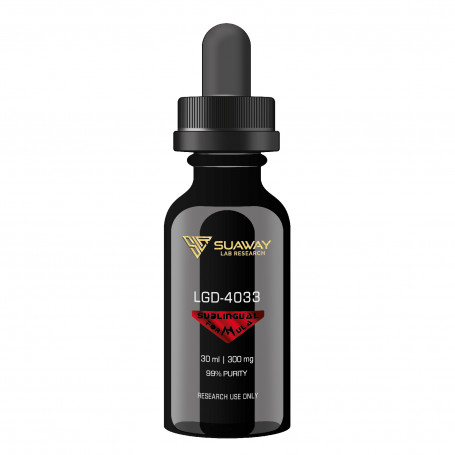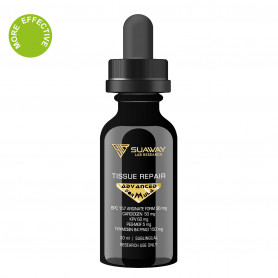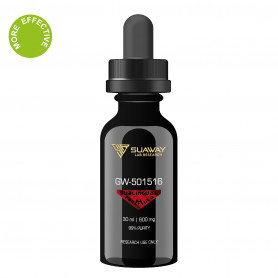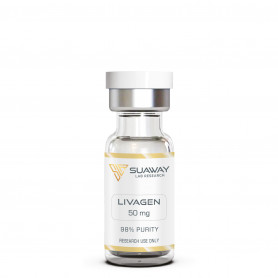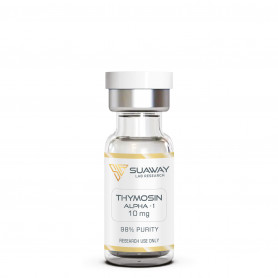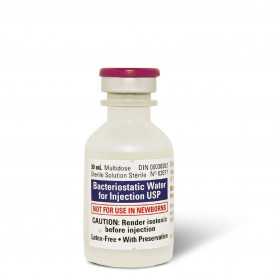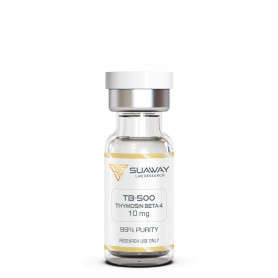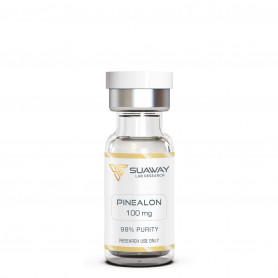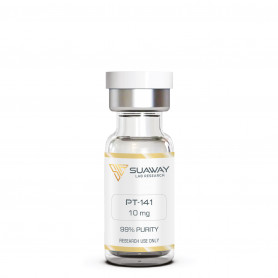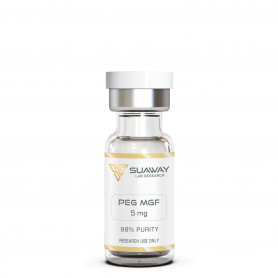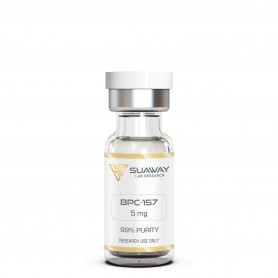LGD-4033 - 30ml/300mg
LGD-4033 is a selective androgen receptor modulator (SARM) currently being researched for its potential applications in the clinical treatment of muscle wasting, osteoporosis and other related conditions.
LGD-4033 is purported to be the most potent SARM currently in clinical trials, with its data exhibiting the most favorable ratio of anabolic activity relative to androgenic activity.
Description
LGD-4033, also known as Ligandrol, is a selective androgen receptor modulator (SARM) developed to be a potential treatment for a variety of musculoskeletal degenerative diseases. The main goal of all SARMs essentially boils down to finding the right compound that provides the same therapeutic benefits of testosterone with improved safety, tolerability and patient acceptance.
So far, LGD-4033 has demonstrated an incredible efficacy profile, and the clinical data suggests it could be a best-in-class small molecule SARM. Despite being the endogenous hormone that men naturally produce, Testosterone use in a clinical setting for treating muscle and bone wasting diseases is extremely limited because of its androgenicity and pharmacokinetic issues.
Testosterone is not selective enough for muscle tissue and bone relative to other androgen affected tissues like the prostate, and is not orally bioavailable. This is why a SARM like LGD-4033 is so promising, as it is non-steroidal, extremely selective, and exhibits a high level of bioavailability. In men, treatment with testosterone and other anabolic androgenic steroids (AAS) could result in prostate growth stimulation and artificially induce hypogonadism, hence why a more selective treatment that can target muscle tissue and bone specifically would be a more desirable alternative. In women, treatment with testosterone or other AAS can lead to the development of male gender characteristics (virilization), hence why a more selective treatment that is capable of fulfilling the same functions of androgens would be a more desirable alternative.
Testosterone induces significant androgenic activity at therapeutic dosages which disqualifies it entirely as an optimal treatment for muscle and bone wasting diseases. This is why SARMs like Ligandrol may prove to be safer, more effective alternatives.
The ideal anabolic agent should demonstrate anabolic selectivity in muscle and bone without suppressing luteinizing hormone (LH), not negatively interact with other steroid receptors in the body, exhibit a high level of oral bioavailability without being 17 alpha-alkylated, and avoid 5-alpha reduction to DHT and aromatization into Estrogen.
SARMs, like LGD-4033, stimulate androgen receptors in a selective way, whereby they induce a significantly greater amount of anabolic activity in the body relative to androgenic activity. It also does not require 17 alpha-alkylation in order to be absorbed and utilized in the body, as opposed to 17 alpha-alkylated oral anabolic steroids that are intentionally designed to be liver toxic with a methyl or ethyl group at the C17α position so they are orally bioavailable. LGD-4033 binds to the androgen receptor with an extremely high affinity and selectivity, and once it does this it exerts anabolic effects in muscle tissue and bone.
The negative effects that stem from traditionally used anabolic steroids converting to 5α-reduced androgens that can increase the risk of benign prostate hyperplasia, prostate carcinoma, acne breakouts, and substantially expedited male pattern baldness could potentially be averted entirely if LGD-4033 became an approved treatment alternative in a clinical setting.
LGD-4033 could potentially provide a sufficient amount of anabolic stimulation to completely mitigate muscle wasting and bone degradation, while simultaneously avoiding the occurrence of androgenic side effects in women entirely. The lack of androgenicity is favorable for both men and women, but it proves especially useful in the context of treating women, as even low dosages of anabolic androgenic steroids would induce virilization.
Finding a balance between a therapeutic amount of anabolic activity with a near complete absence of androgenic activity is extremely difficult to integrate into an anabolic agent, but the clinical data suggests that Ligandrol may be capable of achieving just that. The data revealed a greater than 500-fold selectivity of muscle tissue to prostate in rats. A greater than 500:1 anabolic to androgenic selectivity would make LGD-4033 the most selective SARM to date. In the preclinical rat model of osteoporosis, ovariectomized female rats were allowed to develop osteopenia for eight weeks before once-daily oral treatment with LGD-4033 for 12 weeks.
LGD-4033 successfully increased lumbar spine bone mineral density as effectively as Estradiol and Testosterone (graph on the left), and also significantly decreased trabecular bone turnover compared to placebo. In the preclinical studies castrated rats that were given LGD-4033 experienced increased muscle size, and in a rat model of osteoporosis, the rats experienced increased bone mineral density.
In a preclinical primate model, Cynomolgus monkeys were orally administered Ligandrol once per day at dosages of 0, 0.6, 3, 15, or 75 mg/kg for 13 weeks. Ligandrol treatment resulted in a dramatic increase in lean muscle mass compared to the placebo group. The results showed a significant increase in body weight in both male and female monkeys during the study. After 13 weeks of once per day dosing, there was a significant increase in body weight for all monkeys except the untreated group.
The 75 mg/kg dosing was stopped after 48 days due to signs of toxicity. This isn't very relevant to Viking's Phase 2 clinical trial though, as human dosages did not exceed 2 mg per day. More than than 70% of the mass gained was retained after a four-week recovery period when the weight of the monkeys was checked again. The preclinical data suggests that Ligandrol is highly selective for muscle tissue, and could potentially perform with a much improved therapeutic profile in a clinical setting relative to testosterone.
Phase 1
Three Phase 1 studies on LGD-4033 were successfully accomplished. The Phase 1 trials are the first stage of testing in human subjects designed to assess safety, side effects, best dosage, and formulation method for the drug. The takeaway from all Phase 1 human trials was that LGD-4033 exhibits a very encouraging safety profile and tolerability at dosages that provide significant improvements in lean muscle mass, and positive trends in strength and performance measurements.
Single Ascending Dose Study
The first Phase 1 trial involving LGD-4033 was a randomized, double blind, placebo controlled trial conducted in 2009 on 48 healthy male volunteers. The volunteers were divided into six cohorts and received an escalating daily dosage of LGD-4033 ranging from 0.1 mg per day to 22 mg per day. All doses of LGD-4033 tested in humans (even the 22 mg per day dosage) were shown to be safe and well-tolerated, with predictable pharmacokinetics. The pharmacodynamics results showed dose-dependent reductions in total serum testosterone levels, sex-hormone binding protein (SHBG), and fasting serum HDL, which is consistent with the mechanism of action of SARMs (and all anabolic agents).
21 Day Multiple Ascending Dose Study In Healthy Young Men
The second Phase 1 trial involving LGD-4033 was a placebo-controlled study conducted on 76 healthy men (21–50 years). They were randomized to placebo or 0.1, 0.3, or 1.0 mg LGD-4033 daily for 21 days. Blood counts, chemistries, lipids, prostate-specific antigen, electrocardiogram, hormones, lean and fat mass, and muscle strength were measured during and for 5 weeks after intervention. LGD-4033 was shown to be safe and well-tolerated. There was a dose-dependent suppression of total testosterone, SHBG, HDL cholesterol and triglyceride levels. FSH and free testosterone only showed significant suppression at the 1 mg per day dosage. Lean muscle mass increased significantly in a dose dependent manner, with minimal changes in fat mass. Hormone and lipid profiles all returned to baseline after treatment discontinuation.
There were no drug related serious adverse events, no liver toxicity, no negative effect on electrocardiogram results, and no adverse effects on Prostate-Specific Antigen (PSA) levels. There was a dose proportional increase in drug concentration on days 1 and 21, suggesting that accumulation occurs upon multiple dosing, which is very important to note. If someone took the same dose every 24 hours, LGD-4033 would eventually accumulate to extremely high levels in the blood. It would be wiser to assume the half life is closer to 36 hours based on the clinical data in this study.
LGD-4033 increased lean body mass on average 1.21 kg (2.67 pounds) at the 1 mg dosage. The increase in lean body mass was dose-dependent, and can be assumed will increase more as the dosage increases. The capability of LGD-4033 to increase lean muscle mass in such a short time span without negatively affecting PSA levels bolds well for its efficacy and safety profile moving forward.
7 Day Study In Elderly Men And Women
The third Phase 1 trial involving LGD-4033 was conducted to evaluate the safety, tolerability and pharmacokinetics properties of LGD-4033 in elderly subjects. This study is assumed to be the most representative of the hip fracture population, which is the main clinical application Viking seeks approval for with LGD-4033. The end goal is to receive approval to treat patients who have suffered a hip fracture by slowing or prevent the loss of their lean body mass or bone mineral density. LGD-4033 had predictable pharmacokinetics (similar to those reported in younger male subjects) and was shown to be safe and well-tolerated at all doses evaluated with no serious adverse events observed.
Phase 2
In Phase 2, the scope of treatment applications for LGD-4033 narrows as there needs to be a specific condition that the SARM is meant to treat in order to receive approval. In this trial, the efficacy and safety profile of LGD-4033 in the maintenance or improvement of lean body mass, bone mineral density, and function in patients recovering from non-elective hip fracture surgery is assessed. Negative Changes In Body Composition Following A Hip Fracture.
Hip fracture is associated with a number of morbidities, most of which are a consequence of lean muscle loss and bone degradation following hip fracture surgery. Within the first year after a hip fracture, body fat levels increase by up to 7% on average, while lean muscle mass decreases by up to 11%. Typically, healthy older females without hip fractures would only lose approximately 1% of their lean tissue per year and gain 1.7% body fat. Bone mineral density also severely declines in hip fracture patients. The ability to slow or prevent the loss of lean body mass or bone mineral density would likely have a profound impact on patient recovery following hip fracture.
The first Phase 1 study conducted on LGD-4033 established safety and tolerability of LGD-4033 up to dosages of 22 mg per day in humans. It is very unlikely that 22 mg per day will be necessary to replicate the anabolic properties of Testosterone to prevent the loss of lean muscle or bone mineral density in hip fracture patients, however, it is useful to know that it has established a fairly encouraging safety profile even at dosages as high as 22 mg.
LGD-4033 produced dose-dependent effects on primary and all secondary measures of lean body mass, with significant increases in lean body mass and appendicular lean mass following 12 weeks of daily dosing. The highest dosage utilized in Phase 2 clinical trials was 2 mg per day for therapeutic purposes. In a recreational capacity, it is quite common for men seeking performance enhancement to report using 10 – 20 mg of LGD-4033 per day, with women using 5 – 10 mg per day. These dosages were determined by recreational users based upon anecdotal logs and personal experimentation, and are not concrete guidelines that dictate correct or incorrect use.
Side Effects
While LGD-4033 was generally regarded as safe in human trials using dosages as high as 22 mg per day, that doesn't mean it had no negative side effects. These were some of the negative side effects reported in the clinical data, as well as anecdotally among recreational users.
- Decreased Good Cholesterol (HDL): The clinical data shows dose-dependent suppression of HDL cholesterol and triglyceride levels with LGD-4033 usage. A negative effect on HDL levels is consistently noted as a common side effect of all traditional anabolic steroids, and other SARMs. Despite SARMs ability to be selective about how they exert anabolic activity in the body, they evidently do not differ much from anabolic steroids in regards to their effects on lipid profiles.
- Testosterone Suppression: SARMs have shown to suppress luteinizing hormone (LH) and follicle stimulating hormone (FSH) through the hypothalamus-pituitary-testis axis, thus decreasing testosterone in a dose-dependent manner. Ligandrol suppressed Sex Hormone-Binding Globulin (SHBG) and total testosterone levels in clinical trials in a dose-dependent manner. Serum free testosterone and FSH levels were only suppressed in the subjects treated with 1 mg of Ligandrol. There was no LH suppression in subjects treated with Ligandrol during the 21 day clinical trial conducted on healthy young men. However, the treated groups were only administered either 0.1 mg, 0.3 mg, or 1.0 mg for three weeks, which are relatively low dosages and is also a short time frame.
- Elevated Estrogen Or Decreased Estrogen: LGD-4033 does not aromatize into Estrogen, however, by suppressing natural Testosterone levels it can create an unfavorable balance between Testosterone and Estrogen in the body. By occupying the androgen receptor with such a high affinity, LGD-4033 can divert a significant amount of Testosterone to aromatize into Estrogen that wouldn't have otherwise. The consequence of this is a systemic elevation of Estrogen levels in the body, which is commonly misinterpreted as prohormone laced SARMs.
Common symptoms of high estrogen include: Acne, oily skin, Erectile dysfunction, Low libido, Lethargy, Gynecomastia, Irritability, Depression, Water retention, High blood pressure, Enlarged prostate, Shrunken testicles, Sugar cravings,
While LGD-4033 can cause Estrogen levels to rise via the increased aromatization of circulating Testosterone, long-term use, or high dosages of LGD-4033 can cause an opposite effect, where the body has such a low level of circulating Testosterone via endocrine suppression that the body no longer has enough aromatization occurring to satisfy Estrogen fulfilled physiological functions. Low Estrogen levels can lead to a variety of health problems.
Common symptoms of low estrogen include: Dull weak orgasms, Dry skin and lips, Dehydration, Erectile dysfunction, Low libido, Irritability, Mood swings, Loss of appetite, Fatigue, Lethargy, Decreased bone mass and strength.
In a hypothetical scenario where Ligandrol would be considered as a potential long-term HRT treatment, it would very likely need to be used in conjunction with exogenous Estrogen to maintain healthy blood serum concentrations that would have otherwise been achieved via adequate Testosterone to Estrogen aromatization.
- Androgenic Activity: LGD-4033 exhibits a dose dependent increase in androgen activity in the body. While it is extremely selective for muscle tissue and bone relative to androgen affected tissues, all SARMs (LGD-4033 included) result in systemic increases in androgen activity, therefore there will still be some potential for androgenic side effects. The extent to which this will occur is just far less. As LGD-4033 has an anabolic:androgenic ratio of greater than 500:1, the therapeutic dose necessary to yield the desired level of muscle and bone mineral density retention in hip fracture patients would very likely not be high enough where any notable androgenic activity could occur. In a performance enhancement context, very high dosages would likely result in some notable androgenic side effects in the body.
- 5-Alpha Reduction: SARMs are resistant to metabolism by 5α-reductase and aromatase. The most potent androgen in the prostate is dihydrotestosterone (DHT), which is formed by 5α-reduction of testosterone. 5α-reductase is expressed in high levels in the prostate, and very low levels in muscle tissue. A study that assessed how much of a role endogenous DHT plays when it comes to building muscle discovered that it literally does nothing for gains in muscle mass, and that the conversion of testosterone to DHT is not essential for mediating its anabolic effects on muscle. This is contrary to what many people assumed, as DHT on is such a potent androgen. However, the fact that DHT is expressed in high levels in the prostate, but in low levels in muscle and bone, coupled with the data from that study, exhibits the true significance of DHT in prostate and testosterone in muscle and bone. Ligandrol does not undergo 5α-reduction, which is speculated to contribute to its sparing effect on the prostate and other androgen affected tissues.
This is not the case though, as there are several androgens that do not undergo conversion to a more androgenic compound when undergo 5α-reduction.
PCT (Post Cycle Therapy)
LGD-4033 will suppress natural Testosterone levels in a dose-dependent manner. It is essential to complete a PCT phase (post-cycle therapy) after a LGD-4033 cycle. Due to the half-life of LGD-4033, PCT should be started the day after the last dosage was taken. Forgoing PCT may greatly increase the risk of muscle loss, fat gain, among all of the other standard side effects associated with Testosterone suppression.
DISCLAIMER
This product is intendend for lab research and development use only. These studies are performed outside of the body. This product is not medicines or drugs and has not been approved by the FDA or EMA to prevent, treat or cure any medical condition, ailment or disease. Bodily introduction of any kind into humans or animals is strictly forbidden by law. This product should only be handled by licensed, qualified professionals.
All product information provided on this website is for informational and educational purposes only.

